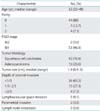1. Jemal A, Bray F, Center MM, Ferlay J, Ward E, Forman D. Global cancer statistics. CA Cancer J Clin. 2011; 61:69–90.
2. Jung KW, Won YJ, Kong HJ, Oh CM, Seo HG, Lee JS. Cancer statistics in Korea: incidence, mortality, survival and prevalence in 2010. Cancer Res Treat. 2013; 45:1–14.
3. Lee YH, Choi KS, Lee HY, Jun JK. Current status of the National Cancer Screening Program for cervical cancer in Korea, 2009. J Gynecol Oncol. 2012; 23:16–21.
4. Lee HP. Annual report of gynecologic cancer registry program in Korea: 1991~2004. Korean J Obstet Gynecol. 2008; 51:1411–1420.
5. Rob L, Skapa P, Robova H. Fertility-sparing surgery in patients with cervical cancer. Lancet Oncol. 2011; 12:192–200.
6. Plante M, Gregoire J, Renaud MC, Roy M. The vaginal radical trachelectomy: an update of a series of 125 cases and 106 pregnancies. Gynecol Oncol. 2011; 121:290–297.
7. Pareja R, Rendon GJ, Sanz-Lomana CM, Monzon O, Ramirez PT. Surgical, oncological, and obstetrical outcomes after abdominal radical trachelectomy: a systematic literature review. Gynecol Oncol. 2013; 131:77–82.
8. Chang SJ, Ryu HS, Nam JH. Uterine artery-preserving laparoscopic radical trachelectomy for early cervical cancer: technical aspects. Gynecol Oncol. 2012; 126:277–278.
9. Kim JH, Park JY, Kim DY, Kim YM, Kim YT, Nam JH. Fertility-sparing laparoscopic radical trachelectomy for young women with early stage cervical cancer. BJOG. 2010; 117:340–347.
10. Nishio H, Fujii T, Sugiyama J, Kuji N, Tanaka M, Hamatani T, et al. Reproductive and obstetric outcomes after radical abdominal trachelectomy for early-stage cervical cancer in a series of 31 pregnancies. Hum Reprod. 2013; 28:1793–1798.
11. Pomel C, Castaigne D, Atallah D, Lauratet B, Camatte S, Morice P, et al. Laparoscopic (type III Piver like) radical trachelectomy [abstract]. Eur J Surg Oncol. 2002; 28:302.
12. Lee CL, Huang KG, Wang CJ, Yen CF, Lai CH. Laparoscopic radical trachelectomy for stage Ib1 cervical cancer. J Am Assoc Gynecol Laparosc. 2003; 10:111–115.
13. Cibula D, Ungar L, Palfalvi L, Bino B, Kuzel D. Laparoscopic abdominal radical trachelectomy. Gynecol Oncol. 2005; 97:707–709.
14. Bafghi A, Castaigne D, Pomel C. Radical trachelectomy: from the laparoscopic approach to the vaginal route. J Gynecol Obstet Biol Reprod (Paris). 2006; 35:696–701.
15. Martin A, Torrent A. Laparoscopic nerve-sparing radical trachelectomy: surgical technique and outcome. J Minim Invasive Gynecol. 2010; 17:37–41.
16. Wang YF, Chen GW, Li WS, Weng HN, Lu XG. Total laparoscopic radical trachelectomy with ascending branches of uterine arteries preservation. Chin Med J (Engl). 2011; 124:469–471.
17. Hong DG, Lee YS, Park NY, Chong GO, Park IS, Cho YL. Robotic uterine artery preservation and nerve-sparing radical trachelectomy with bilateral pelvic lymphadenectomy in early-stage cervical cancer. Int J Gynecol Cancer. 2011; 21:391–396.
18. Rendon GJ, Ramirez PT, Frumovitz M, Schmeler KM, Pareja R. Laparoscopic radical trachelectomy. JSLS. 2012; 16:503–507.
19. Lu Q, Zhang Y, Liu C, Wang S, Guo S, Zhang Z. Total laparoscopic radical trachelectomy in the treatment of early squamous cell cervical cancer: a retrospective study with 8-year follow-up. Gynecol Oncol. 2013; 130:275–279.
20. Shepherd JH, Spencer C, Herod J, Ind TE. Radical vaginal trachelectomy as a fertility-sparing procedure in women with early-stage cervical cancer-cumulative pregnancy rate in a series of 123 women. BJOG. 2006; 113:719–724.
21. Plante M. Evolution in fertility-preserving options for early-stage cervical cancer: radical trachelectomy, simple trachelectomy, neoadjuvant chemotherapy. Int J Gynecol Cancer. 2013; 23:982–989.
22. Regan L, Braude PR, Trembath PL. Influence of past reproductive performance on risk of spontaneous abortion. BMJ. 1989; 299:541–545.
23. Preterm birth. In : Cunningham FG, Gant NF, Leveno KJ, Gilstrap LC, Hauth JC, Wenstrom KD, editors. Williams obstetrics. 21st ed. New York: McGraw-Hill;2001. p. 689–727.
24. Svare JA, Andersen LF, Langhoff-Roos J, Jensen ET, Bruun B, Lind I, et al. The relationship between prior cervical conization, cervical microbial colonization and preterm premature rupture of the membranes. Eur J Obstet Gynecol Reprod Biol. 1992; 47:41–45.
25. Selo-Ojeme DO, Ind T, Shepherd JH. Isthmic stenosis following radical trachelectomy. J Obstet Gynaecol. 2002; 22:327–328.
26. Palaia I, Perniola G, Arrivi C, Sansone M, Pastore M, Calcagno M, et al. Persistent posttrachelectomy cervical stenosis treated with Petit-Le Four pessary in early cervical cancer patients: a report of two cases. Fertil Steril. 2007; 88:1677.e5–1677.e7.





 PDF
PDF ePub
ePub Citation
Citation Print
Print





 XML Download
XML Download